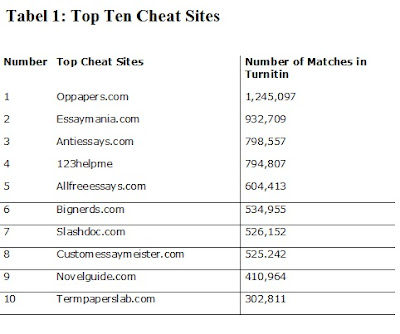KEY FINDINGS
The key findings from the study were:
1. “Students are relying on sources that have weak academic validity” (p. 3).
2. “Most troubling, 18% of content matches come from paper mills and cheat sites” (p. 3). In fact, the statistics showed that there was a 4% increase in the use of paper mills and cheat sites (p. 5)
3. “Secondary student sources vary considerably from the sources higher education students use in their writing” (p. 3).
4. “Educators should consider taking time to teach students how search engines work and how to evaluate and judge the quality of online content” (p. 3).
I find this appalling! I think this statement assumes that we, as educators, do not teach our students how to use search engines. But, you can only spoon feed students so much! When students have waited to the last minute, for whatever reason, they might turn to whatever they think will help them get the page length, etc.
POPULAR SOURCES
The most popular Internet sites are listed below, with Wikipedia remaining in the number one position.
1. Wikipedia
2. Answers.yahoo.com
3. Enotes.com
4. Answers.com
5. Oppapers.com (a paper mill) – personally, I find this to be a very popular source and it disturbs me to find my name on many papers as the instructor.
6. Scribd.com
7. Slideshare.net
8. Essaymania.com
9. Shmoop.com
10. Medialibrary.org
Many students are citing blogs, not realizing that these are mostly filled with opinions.
PAPER MILLS & CHEAT SITES
Educators are debating the value of Wikipedia or SlideShare.net. Some educators recommend using Wikipedia to get an overall idea on the topic, but then recommend using a primary source on the topic. However, educators agree that cheat sites are just not acceptable… period (p. 8).
Roughly, 18% of all matches on Turnitin come from cheat sites. “To put it bluntly at least 18% of all sources used in secondary education papers are plagiarized” (p. 8)
SHOPPING SITES
Want to get a better understanding of what was presented in a textbook or another source? Go to Amazon.com or Barnes & Noble and read the reviews that the authors and readers write. This is where our higher education students are going for information.
CONCLUSION
This is battle that will never be won. Circumstances will always tempt even the best student to take a short cut here or there. It is our responsibility to ensure that we are educating are students in the proper method of research and that they use and cite the right sources when on the web.
Author: Dr. Andree Swanson
Reference
Turnitin. (2013). White paper: The sources in student writing – Secondary education. Oakland, CA: iParadigms, LLC.

No comments:
Post a Comment